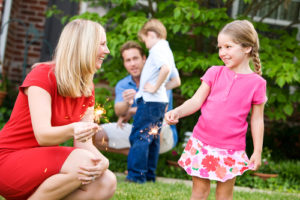We are all aware that the majority of dogs do not appreciate the Fourth of July like we do. While we “ooh” and “ahh” over the beautiful firework displays and the awesome booms, our dogs feel like their eardrums are under siege and the world is coming to an end.
If you have a new puppy at home, you may be wondering how to make its first Fourth of July a good one. After all, this first Fourth will really have an impact on how your dog feels about this holiday the rest of his life. The following tips will help insure your new family member makes it through the day as positively as possible.
Preparation
Start preparing for the Fourth now. Remember, some people will start lighting fireworks off as early as two weeks before the day, so be prepared to start conditioning your puppy then.
What you should have on hand:
- Radio, TV, Fan, or other “white noise” maker to drown out fireworks
- Lot of HIGH VALUE treats and/or toys – don’t be cheap, make sure it is your pup’s absolute favorite
- Kennel (if they are kennel trained)
- Soft Blankets
Conditioning
Begin by finding firework noises online or on a CD of sounds and play it at a very low level (remember, your pup has much better ears than you!), while you play, feed treats, and do whatever else your pup loves most. This creates a relationship between the noise and the food or toy so that your dog will associate it with good things and not be afraid of it.
Do this in short sessions, say 1-2 minutes, and then give your dog a break. Turn the noise off and do something else while your dog relaxes in a kennel or on a mat– be sure to remove the toys and treats at the same time as the sound! This allows your dog to start making the connection that loud booming noises equals good things.
After a break, do another session. I recommend two or three short sessions, with breaks, a day. Slowly raise the volume as your dog gets comfortable.
Watch for signs of stress (cowering, stopped eating or playing, flattened ears, lowered tail, whites of eyes showing, whining) and turn the volume back down if they start displaying any of these.
YES, your dog can tell the difference between the recorded and live fireworks, but this is a start.
Once you have been able to raise the volume to an “average” level (remember, do not turn it up so loud that it’s blaring – you could damage your dog’s ears!), start making “real noises” by banging pots in another room, dropping tin cans, etc. Again, keep your sessions short and be sure you are playing to treating your dog only when there is sound.

Management
Do not take your dog to go watch fireworks up close. Think about how loud they are to you. It is even louder for your dog. It is not only not humane, it can damage their ears (think about going to a motorcycle or car race and being up close with no ear plugs).
Make sure you have plenty of treats and toys for your puppy to enjoy – after all she will most likely have no interest in watching the fireworks.
If she becomes stressed, move further away or leave. It’s not worth stressing your dog out.
Create a “safe space” for breaks
Remember, give your pup breaks! While she may tolerate the noise for a few minutes, if you leave her out there for too long, she may become stressed. Not only is there noise, but usually a lot of people too, which can also be overwhelming. This is also a good time to make sure she is getting water.
If she is crate trained, put a crate in the quietest area, furthest from the noise. If she is not crate trained, then put her in a pen or a closed room. Put in some blankets, cover the crate with a blanket, and then turn on your “white noise” – whether it’s a TV, fan, or radio – to help drown out the fireworks. Give her a Kong® or a favorite chew and make sure she has water.
About the Author
Based in Tustin, Calif., animal lover Kristina N. Lotz is a Certified Professional Dog Trainer – Knowledge Assessed (CPDT-KA) and works as a full time trainer. She also owns her own custom pet products company, A Fairytail House, where she makes personalized collars, leashes, beds, keepsake pillows and blankets, and anything else your imagine can think up. In her spare time, she trains and competes in herding, agility, obedience, rally, and conformation with her Shetland Sheepdogs. She smartly married a Veterinary Technician, who helps keep the fur kids happy and healthy, and provides a quick resource for articles.
